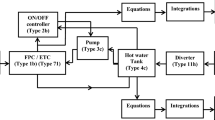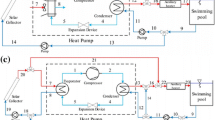Abstract
Aquatic centres are large users of energy for water and space heating with an energy intensity which can be up to seven times that of a commercial office building in Australia. Much of the energy is used to heat water to relatively low temperatures, and therefore, solar energy technology is capable of providing this energy. In the residential sector, solar thermal systems for heating water and swimming pools are well-established. This is not the case for commercial swimming pools i.e. aquatic centres. In Australia, a program to encourage commercial pool operators to install solar systems was funded in the early 1980s. This paper has investigated the current use of and attitudes to solar systems in commercial pools through a survey of municipal pool operators in Victoria, southern Australia. The survey found that there has been very little increase in the use of solar energy and that perceived barriers to the use of the technology remain the same as they were nearly 30 years ago. Lack of roof area, poor payback periods and an inability of solar to meet pool heating needs are the most common misconceptions. The paper investigates these misconceptions by analysing the hot water needs of a large aquatic centre in Melbourne. It was found that there was sufficient roof area to accommodate a solar system that would provide a solar fraction of 0.60 and the simple payback period for a solar system using unglazed solar collectors was approximately 6.7 years at current gas prices. These are predicted to rise significantly making solar energy an even more attractive proposition for commercial pool heating. Failure of past incentives to stimulate the uptake of solar pool heating systems necessitates a revised approach. Key stakeholders (industry bodies, local governments, pool operators, manufacturers, relevant HVAC consultants and research organisations) all need to be involved in an exemplar project to demonstrate the technology’s viability for aquatic centres.



Similar content being viewed by others
References
AIG (2013). Energy shock—the gas crunch is here. Australian Industry Group, Sydney, NSW, Australia.
ARV Industry Database (2009). Aquatic and Recreation Victoria, Australia http://www.aquaticsandrecreation.org.au/newsletter8.html. last Accessed 15th December 2013.
Burch, J., Salasovich, J., & Hillman, T. (2005). An assessment of unglazed solar domestic water heaters. NREL/CP-550-37759, presented at ISES Solar World Congress, Florida, 6–12 August.
Bureau of Meteorology (BoM) (2016a). Mean rainfall in Melbourne, 1970–2016. http://www.bom.gov.au/climate/averages/tables/cw_086282.shtml.
Bureau of Meterology (BoM) (2016b). Mean ambient temperature in Melbourne. http://www.bom.gov.au/climate/averages/tables/cw_086071.shtml.
Chow, T. T., Bai, Y., Fong, K. F., & Lin, Z. (2012). Analysis of a solar assisted heat pump system for indoor swimming pool water and space heating. Applied Energy, 100, 309–312.
Engelken, M., Roemer, B., Drescher, M., Welpe, I., & Picot, A. (2016). Comparing drivers, barriers, and opportunities of business models for renewable energies: a review. Renewable and Sustainable Energy Reviews, 60, 795–809.
Fuller, R. J. (2011). Solar industrial heating practice in Australia—past and current practice. Renewable Energy, 36, 216–221.
Good Practice Guide (1997). Energy efficiency in swimming pool—for centre managers and operators. Retrieved 2 September 2014. <http://www.swimming.org/assets/uploads/library/Energy_Efficiency_in_Swimming_Pools_219.pdf.
Guthrie, K. (1987). Solar heating of public and institutional swimming pools—incentive Scheme, Victorian Solar Energy Council, Melbourne, Victoria, Australia.
Higgs, J. (1984). The solar heating of public and institutional pools. Victorian Solar Energy Council, Melbourne, Australia.
Howat, G. (2005). Aquatic centres with indoor pools outperform those with solely outdoor pools. Australasian Leisure Management, November/December, No. 53.
IEA (2010). Industrial combustion boilers. International Energy Agency, Energy Technology Network, ETSA Program, Technology Brief 101, May.
IEA (2012). Technology roadmap—solar heating and cooling. International Energy Agency, Paris, France.
IPCC (2011). Special report on renewable energy sources and climate change mitigation. Intergovernmental Panel on Climate Change. Geneva, Switzerland, 230 pp.
Kampel, W., Aas, B., & Bruland, A. (2013). Energy-use in Norwegian swimming halls. Energy and Buildings, 59, 181–186.
Katsaprakakis, D. A. (2015). Comparison of swimming pools alternative passive and active heating systems based on renewable energy sources in Southern Europe. Energy (article in press).
Leaversuch, P., & Gibbs, E. (2010). Safety in public swimming pools. Incident Evaluation Report 2009–2010, Royal Life Saving Society Australia, Perth, Western Australia.
Morse, R. N. (2000). Chapter 11—energy. Technology in Australia 1788–1988.
Mousia, A., & Dimoudi, A. (2015). Energy performance of open air swimming pools in Greece. Energy and Buildings, 90, 166–172.
Rajagopalan, P. (2014). Energy performance of aquatic facilities in Victoria, Australia. Facilities, 32(9/10), 565–580.
Rajagopalan, P., & Fuller, R. (2015). Solar heating for commercial swimming pools—experiences in south-eastern Australia. Proceedings of the Asia Pacific Solar Research Conference 2015, Brisbane, Nov-Dec, Publisher: Australian PV Institute, Editors: R. Egan and R. Passey, Dec 2015, ISBN:978–0–646-95016-7 http://apvi.org.au/solar-research-conference/wp-content/uploads/2015/12/P-Rajagopalan_Peer-Reviewed_FINAL.pdf.
RETScreen (2016). Natural Resource Canada. Government of Canada.
Ruiz, E., & Martınez, P. J. (2010). Analysis of an open-air swimming pool solar heating system by using an experimentally validated TRNSYS model. Solar Energy, 84, 116–123.
Sun, P., Wu, J. Y., Wang, R. Z., & Xu, Y. X. (2011). Analysis of indoor environmental conditions and heat pump energy supply systems in indoor swimming pools. Energy and Buildings, 43, 1071–1080.
Sustainability Victoria (2010). Large scale solar thermal systems design handbook. Master Plumbers’Mechanical Services Association of Australia and Sustainability Victoria. Melbourne, Victoria 3000.
Sydney Water Corporation (2011). Best practice guidelines for water management in aquatic leisure centres. Paramatta, NSW, Australia.
Tagliafico, L. A., Scarpa, F., Giulio Tagliafico, G., & Valsuani, F. (2012). An approach to energy saving assessment of solar assisted heat pumps for swimming pool water heating. Energy and Buildings, 55, 833–840.
Trianti-Stourna, E., Spiropoulou, K., Theofilaktos, C., Droutsa, K., Balaras, C. A., & Santamouris, M. (1998). Energy conservation strategies for sports centers: part B. Swimming pools. Energy and Buildings, 27, 123–135.
Weiss, W., & Mauthner, F. (2012). Solar heat worldwide—markets and contribution to the energy supply 2010. Solar Heating and Cooling Programme, International Energy Agency, Paris, France.
Wolfe, P. (2008). The implications of an increasingly decentralised energy system. Energy Policy, 36, 4509–4513.
Acknowledgements
Ken Guthrie, Director of Sustainable Transformation Pty Ltd., is gratefully acknowledged for providing the authors with material which documented the early solar swimming pool heating initiatives in Victoria. Thanks go to the Project Manager of the case study building for providing required information about the energy consumption. The work of Matthew Middleton who conducted the survey of municipal councils as part of his final year research project is also gratefully acknowledged.
Author information
Authors and Affiliations
Corresponding author
Ethics declarations
Conflict of interest
The authors declare that they have no conflict of interest.
Rights and permissions
About this article
Cite this article
Fuller, R., Rajagopalan, P. & Duverge, J.J. Assessment and modelling of the viability of a solar heating system for aquatic centres in southern Australia. Energy Efficiency 10, 1269–1278 (2017). https://doi.org/10.1007/s12053-017-9517-4
Received:
Accepted:
Published:
Issue Date:
DOI: https://doi.org/10.1007/s12053-017-9517-4




